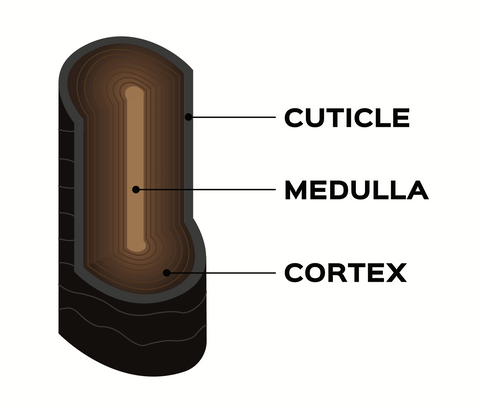The Structure of Your Hair & What it Means For You
You’d never think that those dead cells that frame your face would cause so much trouble in your life. Yes, we’re talking about your hair. Did you know that once your hair shaft reaches the surface of the skin, it dies? Yep, game over. So, just like you probably did once in your high school anatomy class, we’re going to take one of these hair strands and dissect its structure to get a better understanding of how it works. The more you know about the hair’s many layers, the more you can understand how it affects the overall appearance of your hair. Finally, we have some answers for the cause of our frizzy hair!

Outermost Layer: The Cuticle
The Cuticle is essentially your hair’s armor; It’s the layer that protects and nourishes the rest of your hair shaft. Under a microscope, the hair cuticle usually takes on a scaly, shingle-like appearance, of course, depending on the health of it. When we do things like dye our hair or use hot styling tools, those scales tend to raise, allowing harmful chemicals to penetrate the next layer of the hair strand, the Cortex. Over time, these activities can cause permanent damage to the cuticle layer and weaken the overall structure of it. The Scales will remain raised, and you’ll start to notice more tangling, frizz, and a more brittle feel to your hair. Prevent damage by using a protective styling spray and limiting the use of dyes and bleach.
Middle Layer: The Cortex
The Cortex is the thickest hair layer and has several functions. For one, it’s where you can find the melanin that gives your hair its color or pigment. Starting to notice those pesky little gray hairs? Yeah, that’s what happens when your hair is losing melanin. In the cortex layer, long, keratin proteins twist into a chain to give your hair its strength and elasticity. Although it is the thickest part of the hair strand, the cortex layer is primarily affected by the health of the cuticle layer. The first sign of a damaged cortex is that your hair is taking way longer to dry than usual. Why’s that? Well, first, your cuticle layer is damaged and is letting in too much moisture. The cortex, now highly porous because of the cuticle damage, then absorbs that moisture whereas when your cuticle is healthy or only slightly damaged, it will wick away moisture quickly. If the cortex is compromised, you may start to notice breakage, split ends, and lack of elasticity.
Innermost Layer: The Medulla
Consider the Medulla Layer the marrow of the hair structure. It has an oily makeup and is the most fragile component of the three hair layers. In humans, the medulla is often missing or fragmented, usually only present in thicker, more coarse hair. Think of the medulla as a supportive layer.
So, now that you understand the structure of the hair, you can understand why certain products, tools, or habits can cause you to have damaged, dry, or brittle hair. Always be gentle and use products that will support healthy hair growth and maintenance. Check out our line of restorative hair care products if you’re suffering from dry, damaged, or over-processed hair.

